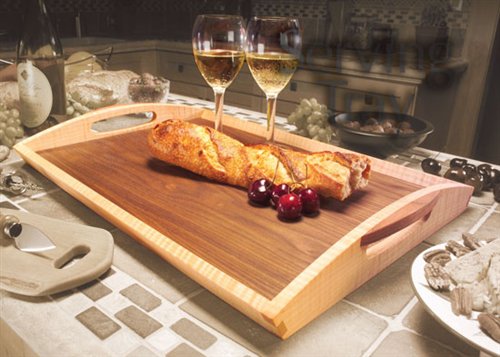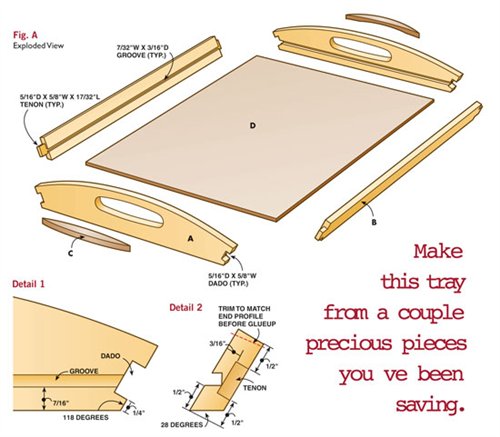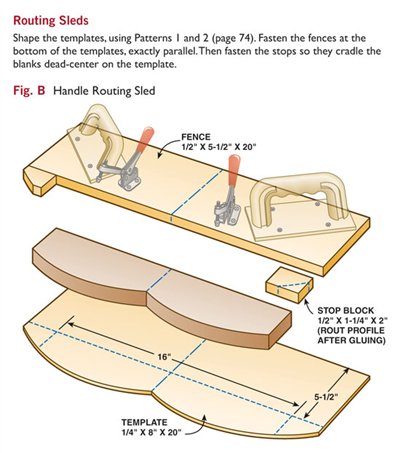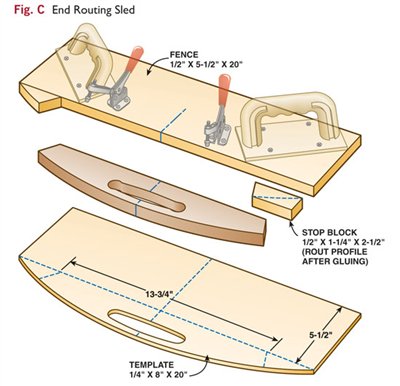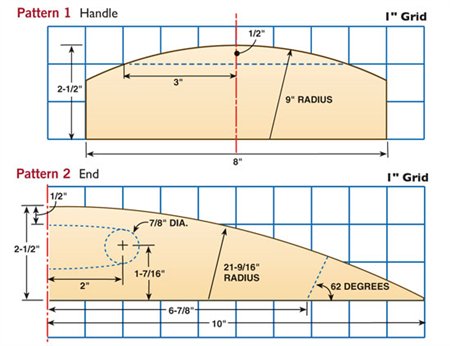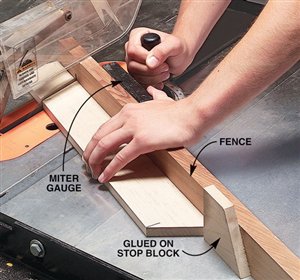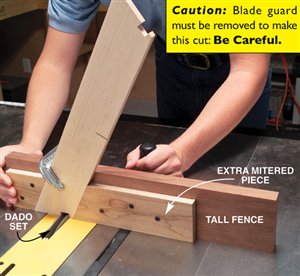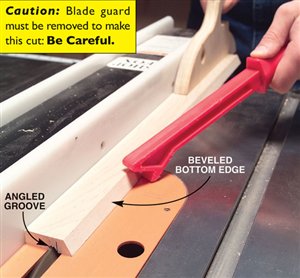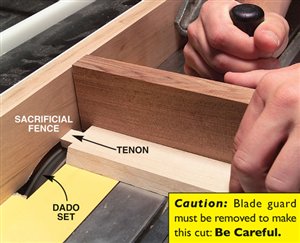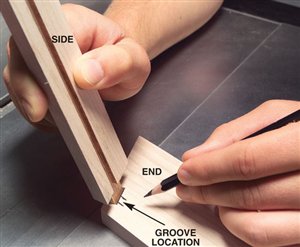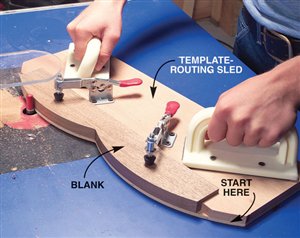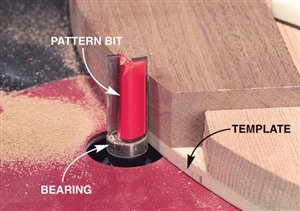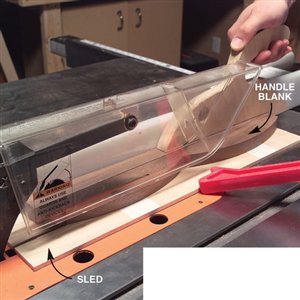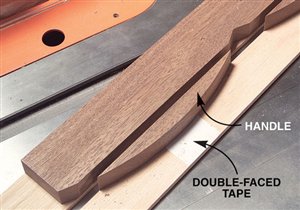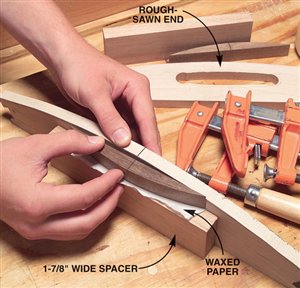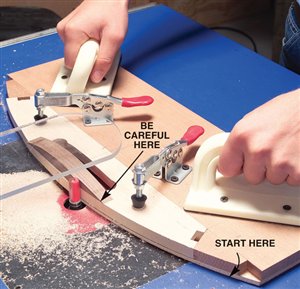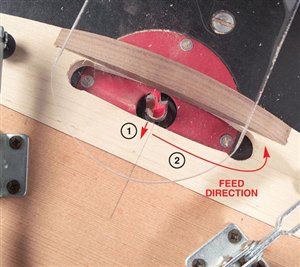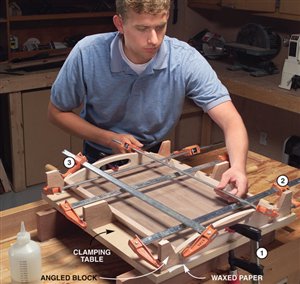We may receive a commission when you use our affiliate links. However, this does not impact our recommendations.
Serving Tray
Make one or many: simple shop-made jigs guarantee success.
By Tim Johnson
|
Snacks, hors d’oeuvres or breakfast in bed: this tray delivers the goods in style. It weighs almost nothing, but it’s built to last, and it requires so little wood that you probably won’t even have to go to the lumberyard. The jigs we’ve designed allow you to make these elegant trays in multiples. It’s a good idea to make a practice tray as you make the jigs, so you can test the results and make adjustments. The cool-looking corner joints are easy to make on the tablesaw, thanks to a simple miter gauge jig and a couple of fences. Shop-made routing sleds allow you to template-rout the arched ends, rounded cutouts and curvy handles on the router table. We’ve even devised a surefire clamping procedure, for gluing. If you follow our how-to, you’re sure to succeed.
ToolsYou’ll need a dado set for your tablesaw and a pattern bit for your router table (a pattern bit is a flush-trim bit with the bearing mounted between the cutting flutes and shank; see Sources, below). You’ll also need a planer to mill the 1/2-in.-thick sides and ends, a jigsaw to rough-cut the curves, and a drill press with a 7/8-in. Forstner bit to establish the curved ends of the handle cutouts. We used a disc sander and a half-round file to true the roughsawn arches and cutouts on our 1/4-in.-thick routing templates. If you don’t have a disc sander, smooth out the arches with a sanding block.
Miter the ends firstCut the blanks for the sides, ends and handles (Fig. A, Parts A through C). Make extra parts of each, for testing your setups and to use in the jigs you’ll be making. Set your miter gauge 28 degrees from perpendicular (at either 62 degrees or 28 degrees, depending on how your miter gauge is calibrated) and attach a long fence. Then miter one end of all your end blanks (A). On the bottom edge of one end blank, mark the 13-3/4-in. final length, measuring from the mitered end. Use this marked blank to install a stop block on your fence so you can miter the other end of the blanks (Photo 1). Cut the dadoes (Fig. A, Detail 1) with a dado set and a jig that holds the end piece on its beveled edge (Photo 2). To make the jig, attach a tall fence to your miter gauge and fasten two of your extra mitered pieces to the fence. Be sure the end’s bottom edge rests flat on the saw table when it’s clamped in place. The dado starts 1/4 in. away from the end’s bottom edge.
Bevel the sidesTilt the tablesaw’s blade to 28 degrees so you can bevel the bottom edges of the sides (Fig. A, Detail 2). The bevel angle is the same as that on the mitered ends. To get a smoothly sawn surface, make two beveling passes. First establish the bevel by setting the rip fence to leave the blank slightly wide (about 1/16 in. oversize). Then reset the fence and make a light clean-up pass to final width. Leave the blade at the same angle to cut the grooves for the plywood bottom, starting 1/2 in. from the bottom edge (Photo 3).
Fit the corner jointsSet up the saw to cut the half-lap tenons on the sides. You have to remove the blade guard for this procedure, so be careful. Install the dado set and lower it below the saw table. Then make a sacrificial fence to house the dado set, so you can crosscut the tenons to length (Photo 4). Setting the blade height to cut the cheeks and bottom faces of the tenons is fussy, because the tenons have to fit just right. Use the dadoes on one of the end pieces to mark the location of the tenons on an extra side piece. Then cut the tenon cheeks, starting out “fat,” and adjust the blade height until you get the proper fit. Cut the back face of the tenon last. This cut removes the slot for the plywood bottom, so it won’t show when the tray is assembled.
Fit the plywood bottomThe last joinery step is to cut grooves in the end pieces for the bottom. Dry-fit the sides and ends so you can transfer the location of the grooves (Photo 5). Cut these grooves straight, not angled like the ones in the sides, but use the same multiple-pass technique to make them wide enough. Dry-fit the tray’s bottom, to make sure it fits. Lay one of the ends flat on your bench and insert the bottom into the groove. Then engage the bottom in the side’s grooves and slide them down to meet the end. If the bottom is too wide, the tenons won’t fit. If the bottom is too long, you won’t be able to install the other end.
Make sleds for routing the curvesAll of the curved shapes are template-routed, using two shop-made sleds, for safety (Figs. B and C, below). Each sled consists of a template, a fence and two stops. Toggle clamps hold the blanks securely and push blocks give you excellent control of the sled (see Sources, below). Use a photo copier to enlarge the patterns (1 and 2, below) for the templates by 256 percent. Because copiers aren’t always accurate, check your enlargements and make necessary adjustments so your patterns match the stated dimensions.
Saw the blanks oversizeInstall each blank in the sled and mark the curves and cutouts. Then rough-saw the blanks to within 1/16 in. of the lines. To cut out the handles, you’ll have to drill a pilot hole for your jigsaw blade on the end pieces. If you have a drill press, install stop blocks and drill 7/8-in.-dia. holes near each end of the cutout. Then simply saw out the middle.
Make the handlesBoth handles are routed and sawn from a large blank, because they’re too darn small to safely machine individually (Photos 6 and 7). You have to rout into the grain on the front side of each arch, so make light passes and go slowly to avoid tear-out. The routing sled is a big help, because it gives you such great control of the workpiece. Sawing the narrow, rounded handles free from the blank is easy and safe when you use a simple plywood sled (Photo 7). Without the sled to stabilize the small off-cut handles, it’s possible for them to spin back into the blade and kick back. It’s important to saw the handles accurately, 1/2-in. wide at the center. Sawing a bit wider makes them a lot longer; sawing a bit thinner makes them a lot shorter. When you set the fence, remember that the handles are offcuts—you have to compensate for the saw kerf.
Attach the handles to the endsCut 1-7/8-in.-wide spacer blocks to hold the 3/4-in.-thick handles at the right height for gluing (Photo 8). Mark centerlines on the handles. Apply a thin bead of glue and rub the handle back and forth against the end. Let the joint sit for a couple of minutes before clamping, so the pieces won’t slide around when you apply pressure.
Rout the arches and handle holesRouting the arches is similar to routing the handles. Be careful on the front side of the arch and take advantage of the control the sled gives you (Photo 9). To rout the handle hole, move counterclockwise around the inside edge (Photo 10).
AssemblyDry-fit the tray, including the bottom. The sides will be slightly taller than the ends (Fig. A, Detail 2, below). Plane or sand them flush. Finish-sand all of the parts prior to gluing and clamping. It’s best to glue the tray together all at once (Photo 11). This requires careful clamping, so use glue that sets up slowly. Gluing the bottom in addition to the corner joints makes the tray very rigid. Don’t go crazy with the glue, or you’ll have a lot of squeeze out to clean up. Just coat the mortises in the ends and run a bead in all the grooves for the bottom. You’ll need a 20-in. x 22-in. clamping table (we used 3/4-in. MDF), five 24-in.-capacity adjustable clamps and two small clamps to hold the ends flat to the clamping board. We used 2×4 risers to make room for the end clamps. Our angled clamping blocks were offcuts.
Spray on the finishAfter gluing, you’ll have to do some touch-up sanding to flush the joints and round any sharp edges. Vacuum the tray, wipe it with a tack cloth and it’s ready for finishing. Aerosol-spray polyurethane is a perfect finish for this project. Set the tray upside-down and spray the bottom and outer sides first. After the poly is dry, turn the tray over and spray the inside and the top edges. Spray three coats on each side, sanding between each coat. Sources(Note: Product availability and costs are subject to change since original publication date.) Seven Corners Hardware, 7corners.com, 651-224-4859, Top bearing flush-trim pattern bit, 1/2-in. dia.; 1-in. flute; 1/4-in. shank, Freud 50-102. Cutting ListFig. A: Exploded ViewRouting SledsShape the templates, using Patterns 1 and 2 (below). Fasten the fences at the
Fig. B: Handle Routing SledFig. C: End Routing SledPatternsThis story originally appeared in American Woodworker October 2003, issue #103. |
Click any image to view a larger version. 1. Miter the end pieces, using a stop block, so they’re all the same length. From the same setup, miter the extra pieces you’ll need to make the jig for the next step (Photo 2).
2. Cut dadoes in the mitered ends, using a dado set.A jig made from extra mitered pieces makes dadoing safe, precise and repeatable.
3. Cut beveled edges on the sides and angled grooves to house the plywood bottom. Use a regular blade to cut the groove, making two or three passes, so the plywood fits snugly.
4. Cut half-lap tenons on the sides, using the miter gauge, a sacrificial fence and your dado set. The fence setting determines the tenon’s length. The tenon’s width and thickness are determined by blade height.
5. Transfer the location of the groove from the side to the end, after assembling the corner joint. This method is more accurate than using a ruler.
6. Rout both handles from one piece of wood, using a flush-trim pattern bit and a shop-made template-routing sled (Fig. B, below).
7. Saw the handles from the blank, using a sacrificial sled—nothing more than a scrap of plywood. Fasten the blank to the sled with double-faced tape, so the small handles stay attached and stable after the cut.
8. Glue the handles on the roughly-shaped ends. Use centerlines and a spacer to hold the handle level and at the right height. Waxed paper keeps the spacer from accidentally getting glued on.
9. Rout the arched end and the handle at the same time, using a sled and a pattern bit (Fig. C, below). Be especially careful not to blow out the protruding front end of the handle.
10. Rout the handle hole. With the power off, center the bit in the hole. Make sure the sled doesn’t move when you power up. Push the sled forward into the bit (1) and advance the cut counterclockwise around the inside of the hole (2). Make very light passes and go slowly.
11. Angled blocks and a flat surface put clamp pressure on the joints. First clamp the ends to a piece of MDF (1). Then clamp the sides to the ends, using angled blocks (2). Finally, clamp the ends to the sides (3). |
Here are some supplies and tools we find essential in our everyday work around the shop. We may receive a commission from sales referred by our links; however, we have carefully selected these products for their usefulness and quality.



